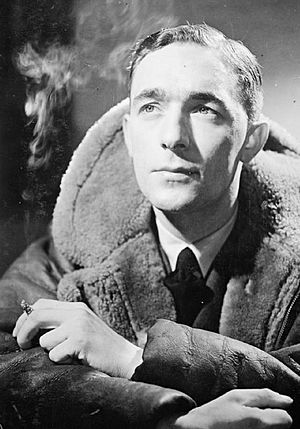Donald Kingaby facts for kids
Quick facts for kids
Donald Ernest Kingaby
|
|
|---|---|

Kingaby during the Second World War
|
|
| Nickname(s) | Don |
| Born | 7 January 1920 Holloway, London, England |
| Died | 31 December 1990 (aged 70) Westfield, Massachusetts, U.S. |
| Allegiance | United Kingdom |
| Service/ |
Royal Air Force |
| Years of service | 1939–1958 |
| Rank | Wing Commander |
| Commands held | No. 72 Squadron RAF (1949–52) Hornchurch Wing (1943) No. 122 Squadron RAF (1942–43) |
| Battles/wars | Second World War |
| Awards | Distinguished Service Order Air Force Cross Distinguished Flying Medal & Two Bars Distinguished Flying Cross (United States) Croix de guerre (Belgium) |
Donald Ernest Kingaby (7 January 1920 – 31 December 1990) was a brave pilot in the Royal Air Force (RAF) during the Second World War. He was known as a "flying ace" because he shot down many enemy planes. He was the only person ever to receive the Distinguished Flying Medal three times, which is a very special award for bravery in the air.
During his time flying, Kingaby took part in about 300 missions. He shot down 21 enemy aircraft by himself. He also helped shoot down two others. He damaged 11 more planes and probably shot down six others. A lot of his victories, 14 of them, were against the German Messerschmitt Bf 109 fighter plane.
Contents
Early Life
Donald Kingaby was born in Holloway, London, on January 7, 1920. His father was a clergyman. Before the war started, he worked for an insurance company. He went to a school called King's Ely.
RAF Career: Becoming a Flying Ace
Kingaby joined the Royal Air Force Volunteer Reserve in April 1939. He was 19 years old. In June 1940, he became a sergeant pilot. He joined No. 266 Squadron and flew the Supermarine Spitfire Mark I.
Battle of Britain Hero
During the Battle of Britain, Kingaby showed his skill. He damaged two German Junkers Ju 88 bombers. He also damaged a Bf 110 fighter plane. In September 1940, he moved to No. 92 Squadron.
On September 30, he shot down a Bf 109. In the second half of October, he claimed four more enemy planes. Three of these were Bf 109s. November was an amazing month for him. He shot down six Bf 109s. Four of these, including one probable, were on a single day, November 15.
The "109 Specialist"
In 1941, the RAF started flying more missions over Europe. Kingaby, with 92 Squadron, shot down 12 more planes. The newspapers called him the "109 specialist." This was because he was so good at fighting the Bf 109s. On November 22, 1941, he became a pilot officer. He then took a break from flying missions.
In March 1942, Kingaby was back in action. He joined No. 111 Squadron. In April, he moved to No. 64 Squadron. There, he shot down two more German fighters. He was promoted to flying officer on June 30.
Later that year, Kingaby became a flight commander. He then became a squadron commander for No. 122 Squadron. On January 20, 1943, Kingaby shot down a German pilot named Helmut Peters. On February 2, he was promoted to flight lieutenant. In March, he was chosen to lead the "Hornchurch Wing" of planes.
End of the War and Awards
After a break, Kingaby returned to flying in the summer of 1944. He was a wing leader over the beaches of France during the Normandy landings. His last victory was helping to shoot down a Bf 109 on June 30. This brought his total to 21 enemy planes.
On July 24, he was promoted to squadron leader. He was then sent to a gunnery school. He stayed there until the war ended. By the end of the war, he was an acting wing commander. He received the Distinguished Flying Cross (United States) from the United States on May 15, 1945. He also received the Croix de guerre from Belgium on June 15.
After the War
After the war, Kingaby stayed in the RAF. He became a permanent flight lieutenant on November 29, 1946. From February 1949 to April 1952, he commanded No. 72 Squadron. During this time, he flew de Havilland Vampire jets. On June 5, 1952, he was awarded the Air Force Cross (United Kingdom).
Later Life
Donald Kingaby continued to serve in the RAF until September 29, 1958. He retired with the rank of wing commander. After retiring, he moved to the United States. He lived in Massachusetts until he passed away on New Year's Eve, December 31, 1990.
Images for kids


